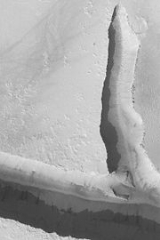
Cerberus Fossae
Encyclopedia
The Cerberus Fossae are a series of semi-parallel fissures on Mars
formed by faults which pulled the crust apart in the Cerberus region (9°N, 197°W). Ripples seen at the bottom of the fault are sand blown by the wind http://photojournal.jpl.nasa.gov/catalog/PIA05498.
The underlying cause for the faulting was magma pressure related to the formation of the Elysium Volcanic field, located to the northwest. The faults pass through pre-existing features such as hills, indicating that it is a younger featurehttp://themis.asu.edu/zoom-20050321a. The formation of the fossae is suspected to have released pressurised underground water, previously confined by the cryosphere
, with flow rates up to 2 × 106 m3s−1, leading to the creation of the Athabasca Valles
.
However, early radar analysis suggests there's no evidence of 'pack ice' tens of metres thick as hypothesised based on the images from Mars Express of the area. This is in support of the US view of images of the area, based on impact crater morphology which do not show any evidences of meteorite hitting anything but solid stone lava fields.
Mars
Mars is the fourth planet from the Sun in the Solar System. The planet is named after the Roman god of war, Mars. It is often described as the "Red Planet", as the iron oxide prevalent on its surface gives it a reddish appearance...
formed by faults which pulled the crust apart in the Cerberus region (9°N, 197°W). Ripples seen at the bottom of the fault are sand blown by the wind http://photojournal.jpl.nasa.gov/catalog/PIA05498.
The underlying cause for the faulting was magma pressure related to the formation of the Elysium Volcanic field, located to the northwest. The faults pass through pre-existing features such as hills, indicating that it is a younger featurehttp://themis.asu.edu/zoom-20050321a. The formation of the fossae is suspected to have released pressurised underground water, previously confined by the cryosphere
Cryosphere
The cryosphere is the term which collectively describes the portions of the Earth’s surface where water is in solid form, including sea ice, lake ice, river ice, snow cover, glaciers, ice caps and ice sheets, and frozen ground . Thus there is a wide overlap with the hydrosphere...
, with flow rates up to 2 × 106 m3s−1, leading to the creation of the Athabasca Valles
Athabasca Valles
Athabasca Valles is an outflow channel on Mars, cut into its surface by catastrophic flooding. It is one of the youngest known of these structures, probably forming only in the geologically recent past of Mars. The flood produced distinctive "teardrop" landforms similar to those found in the...
.
However, early radar analysis suggests there's no evidence of 'pack ice' tens of metres thick as hypothesised based on the images from Mars Express of the area. This is in support of the US view of images of the area, based on impact crater morphology which do not show any evidences of meteorite hitting anything but solid stone lava fields.

